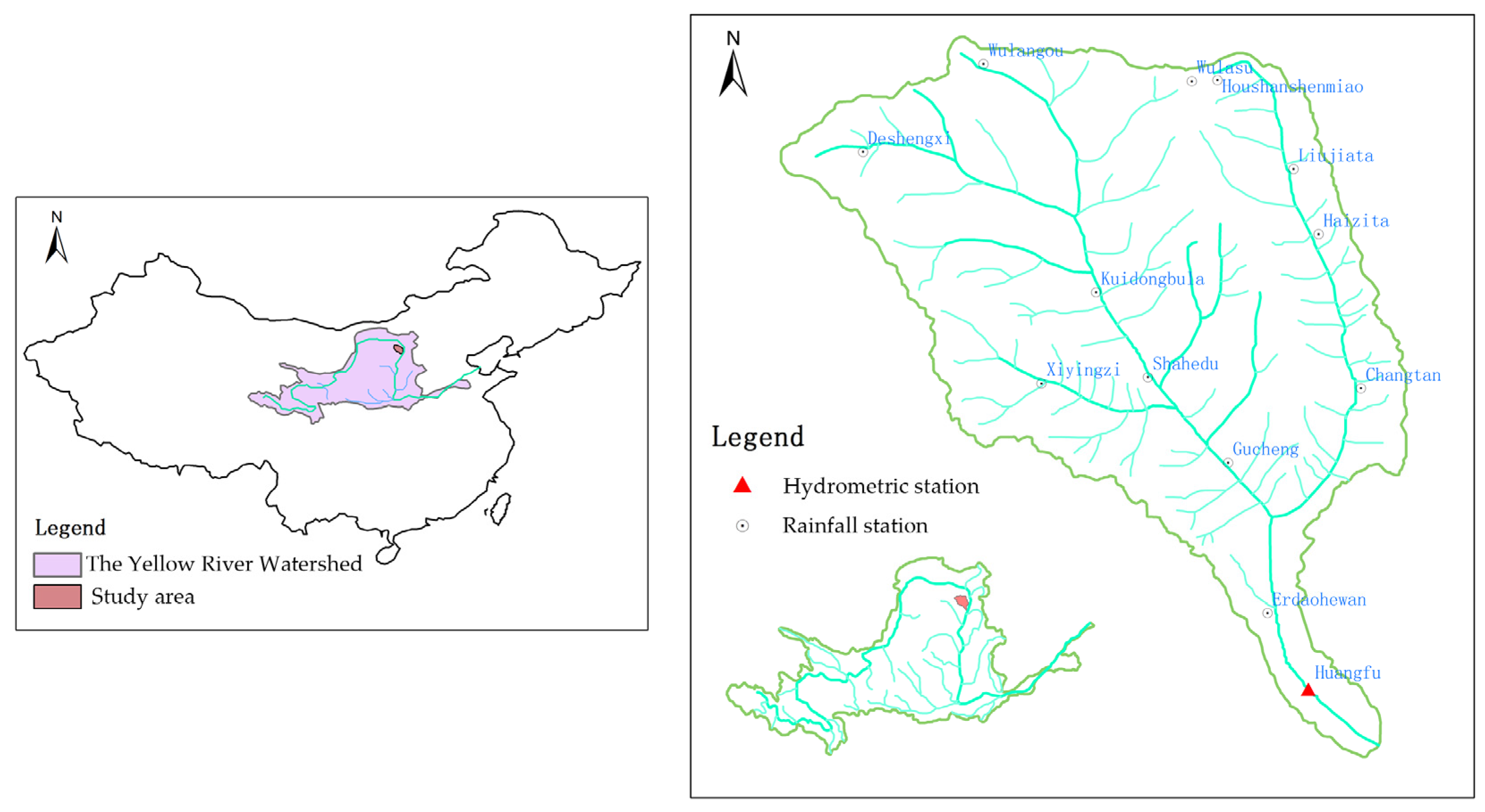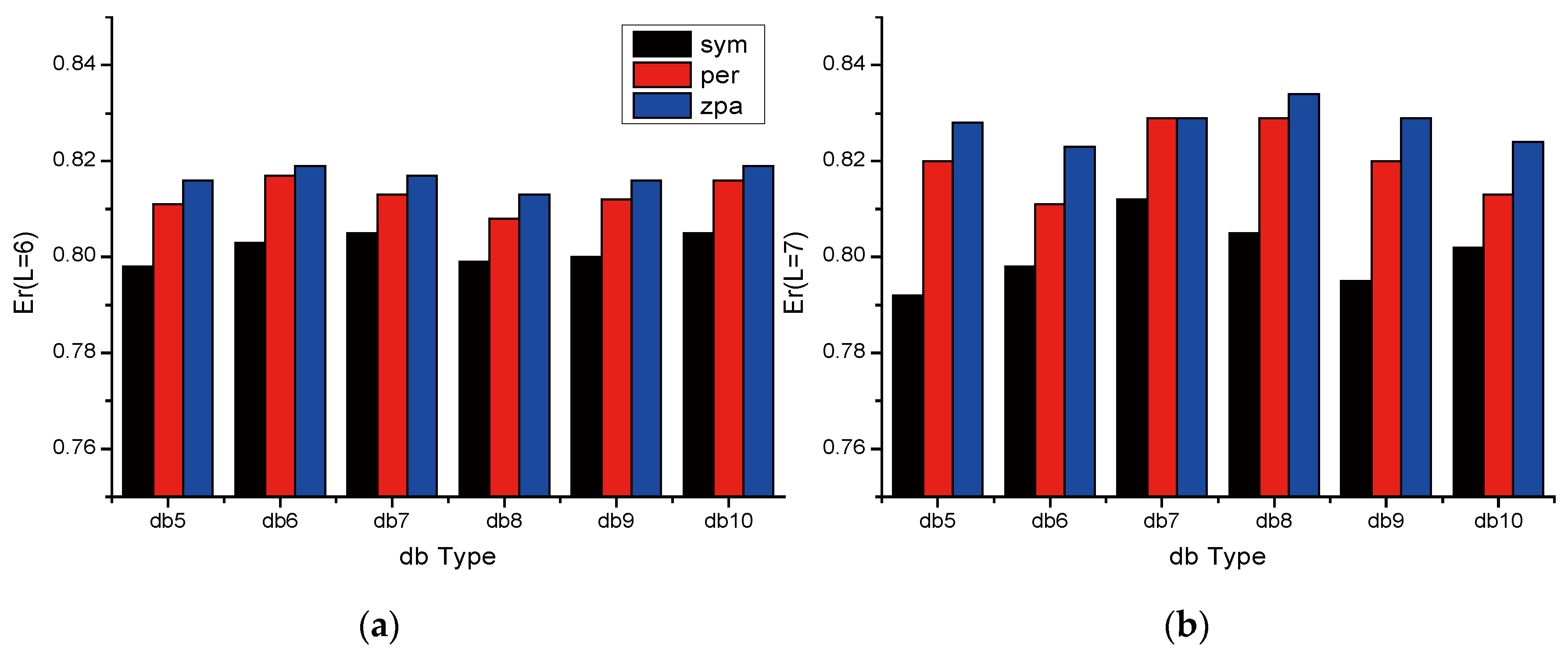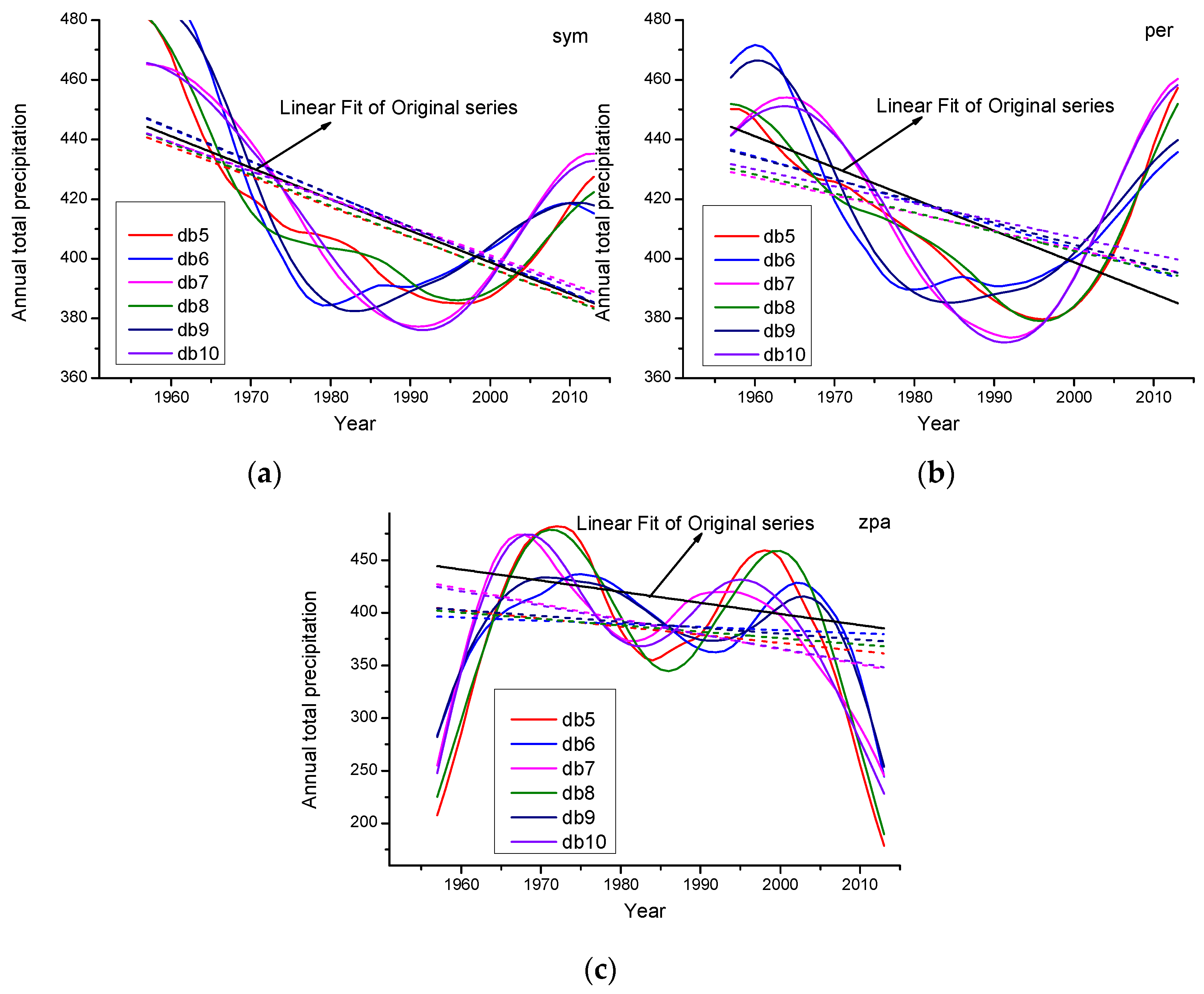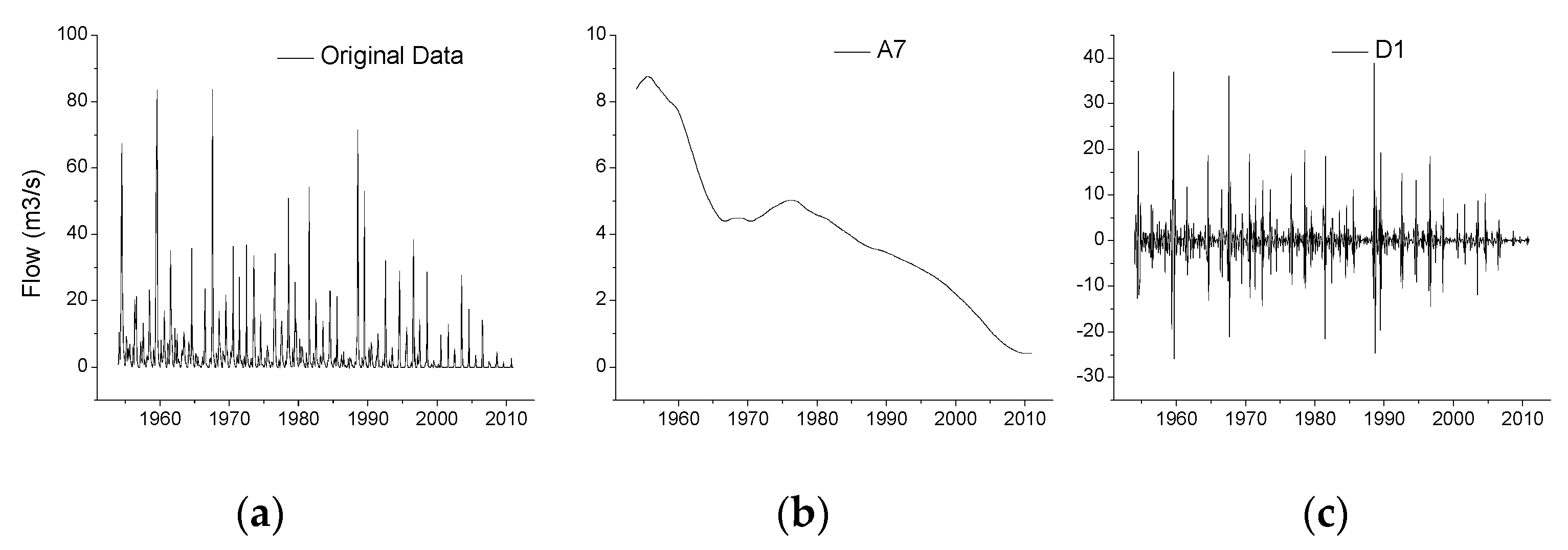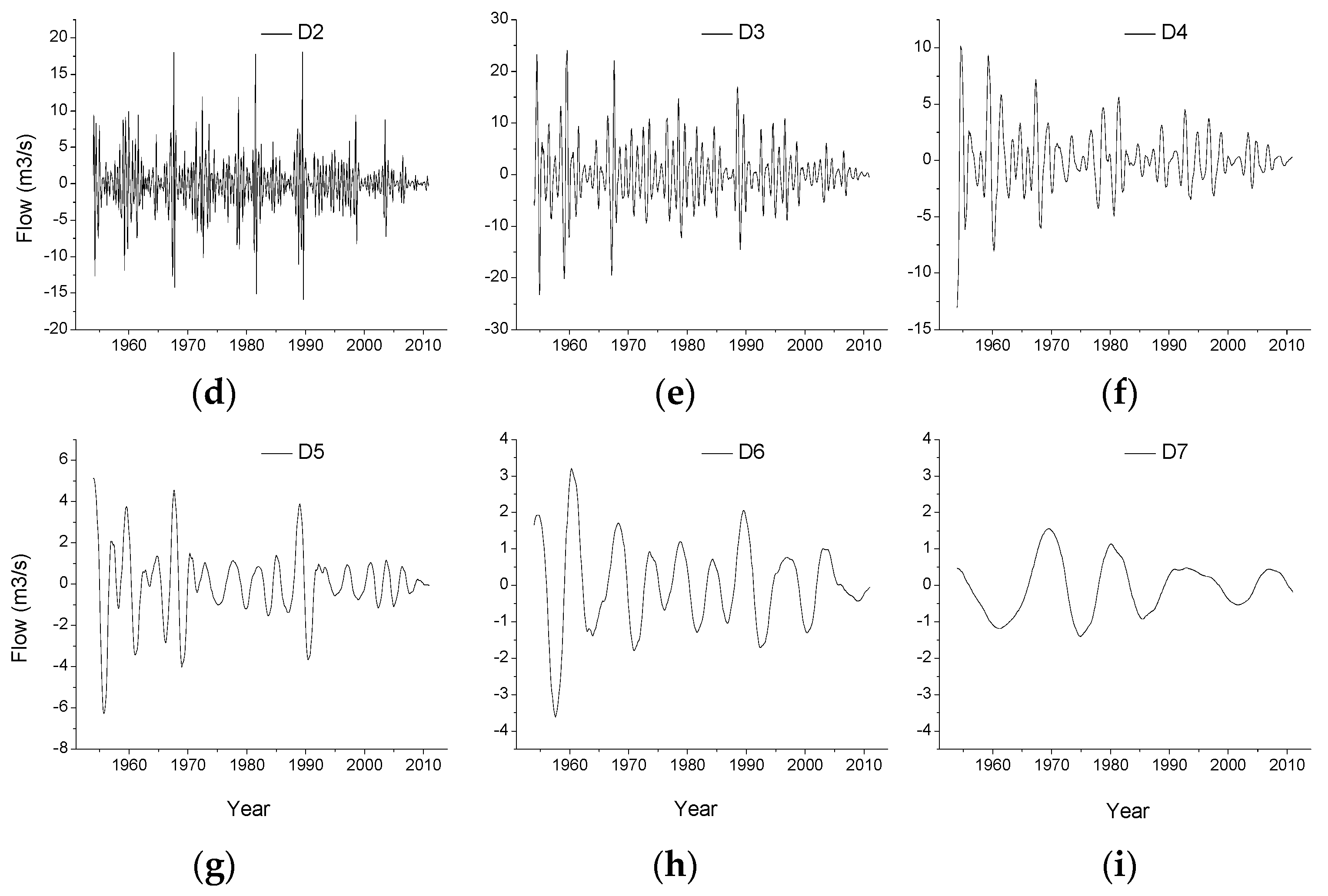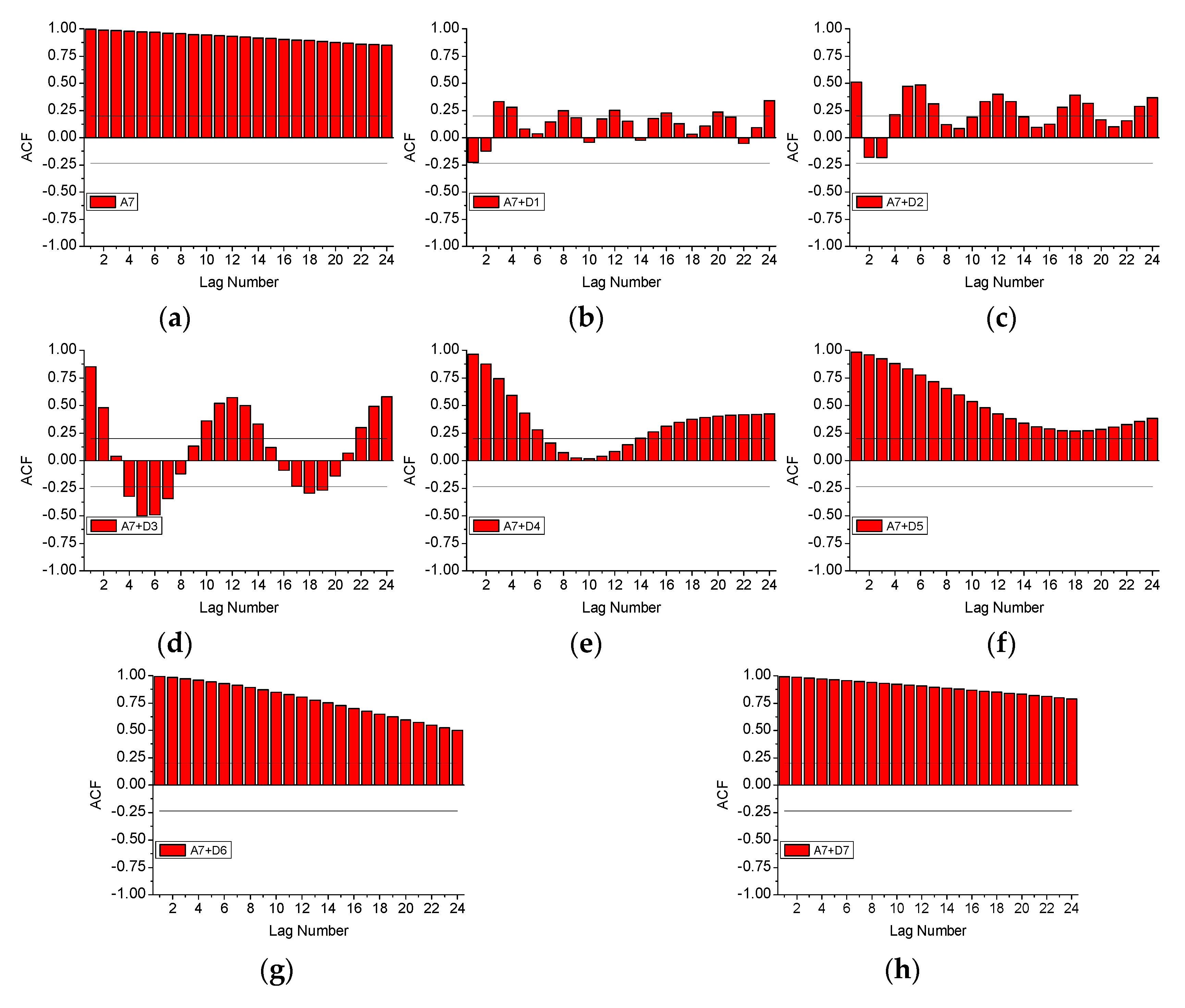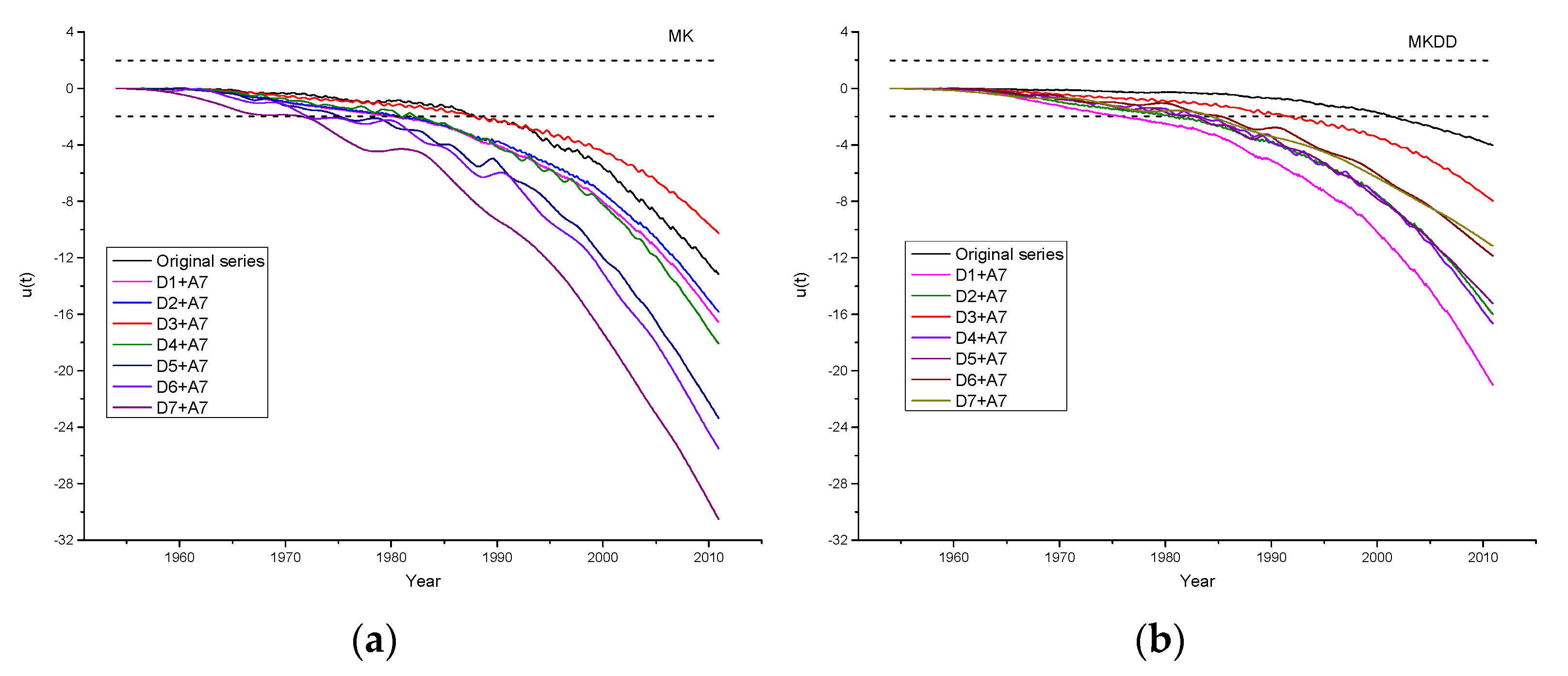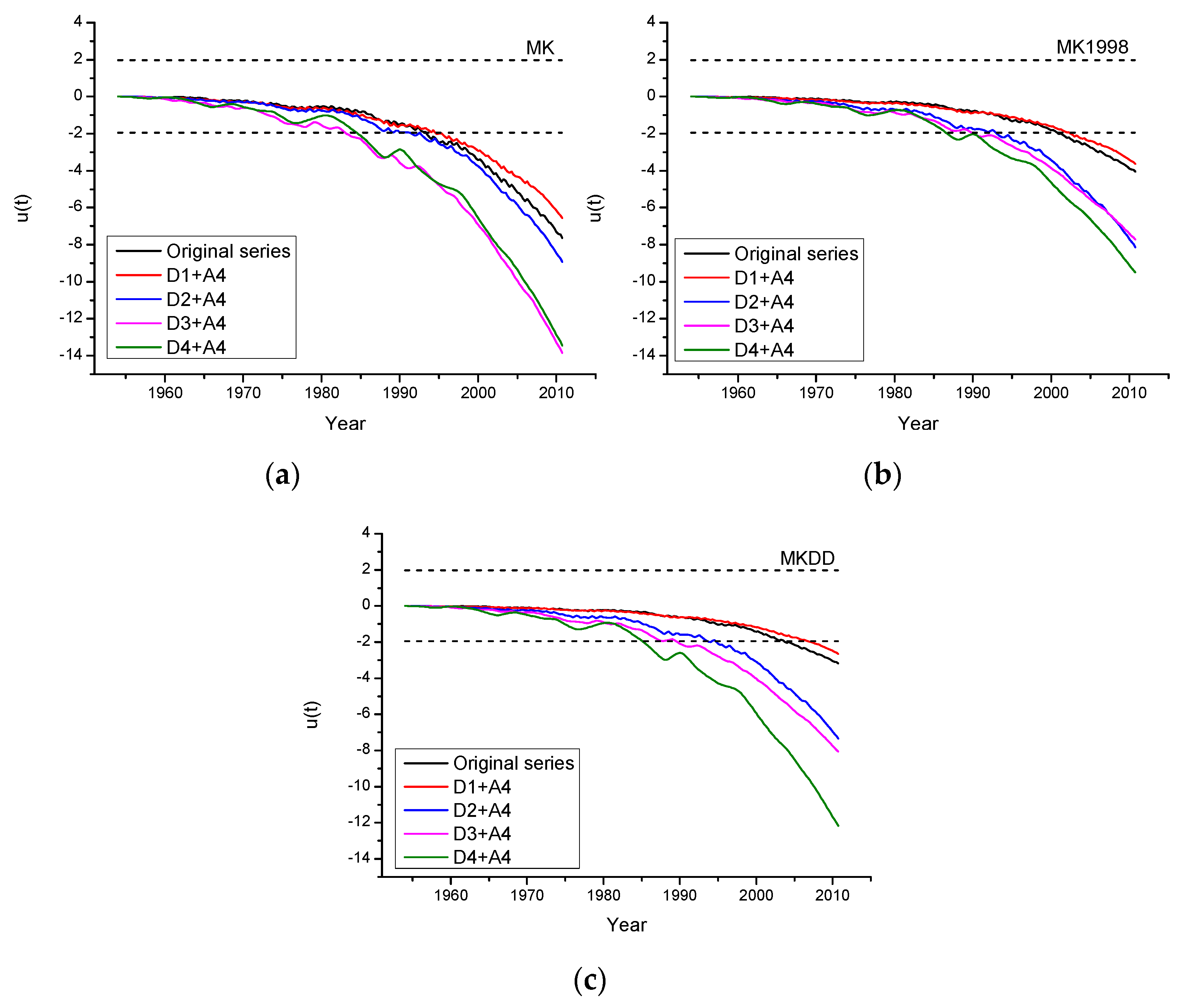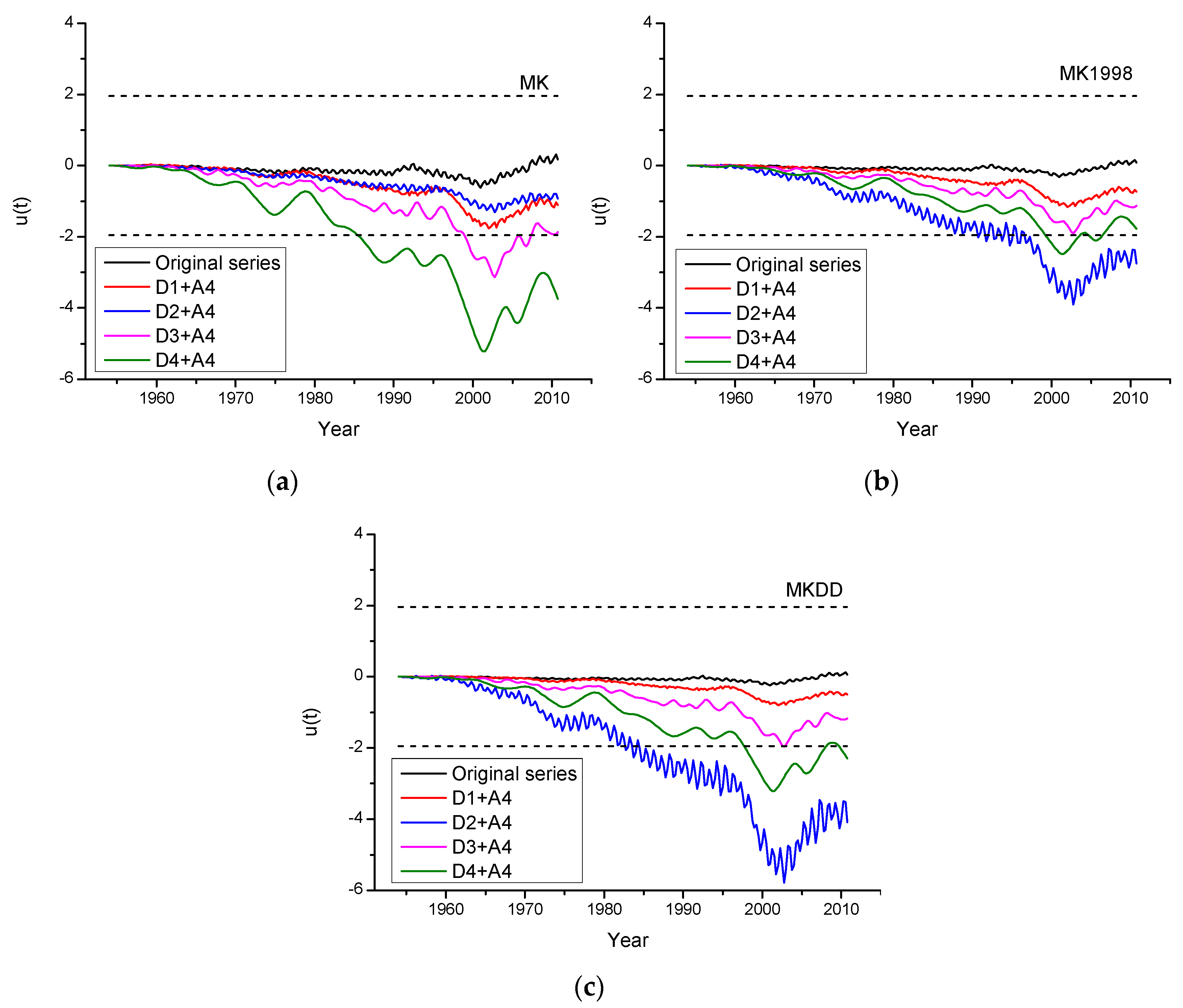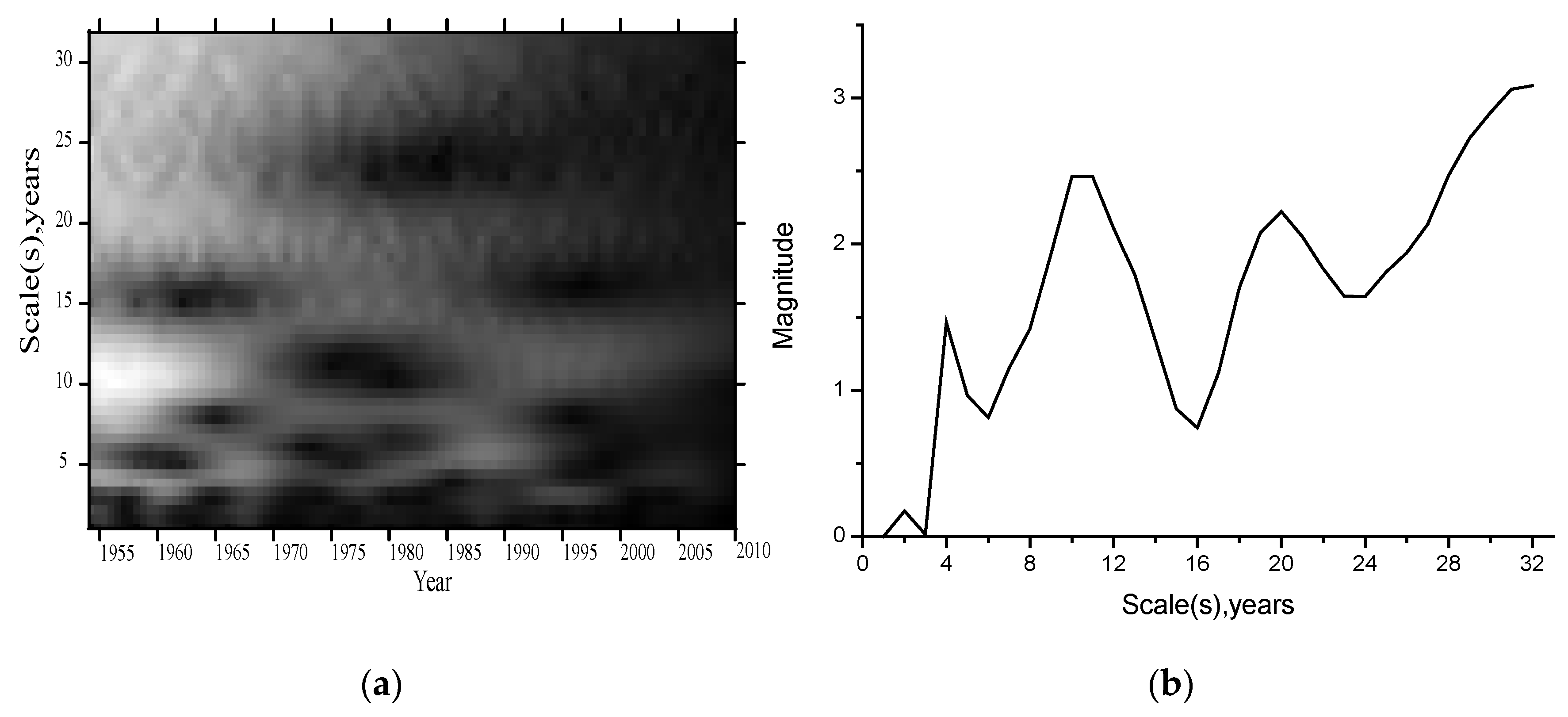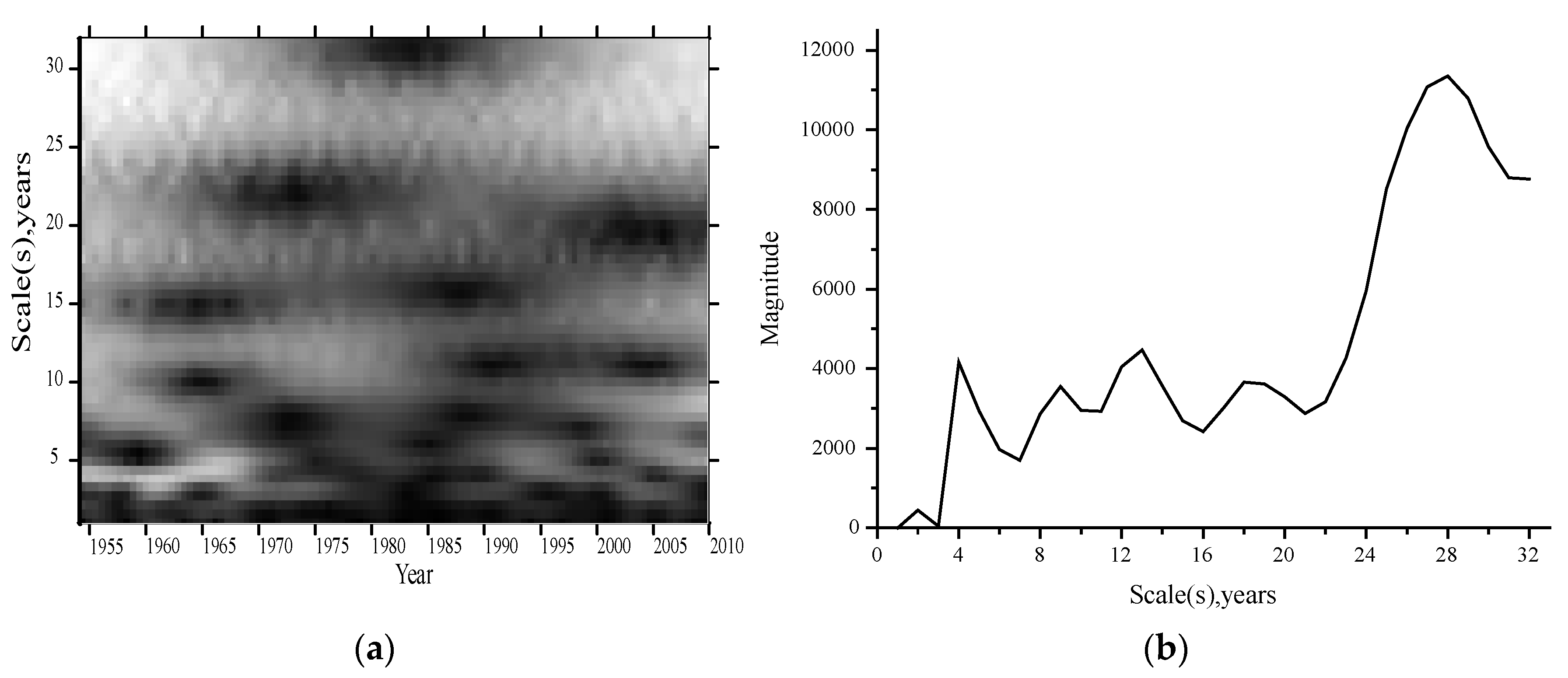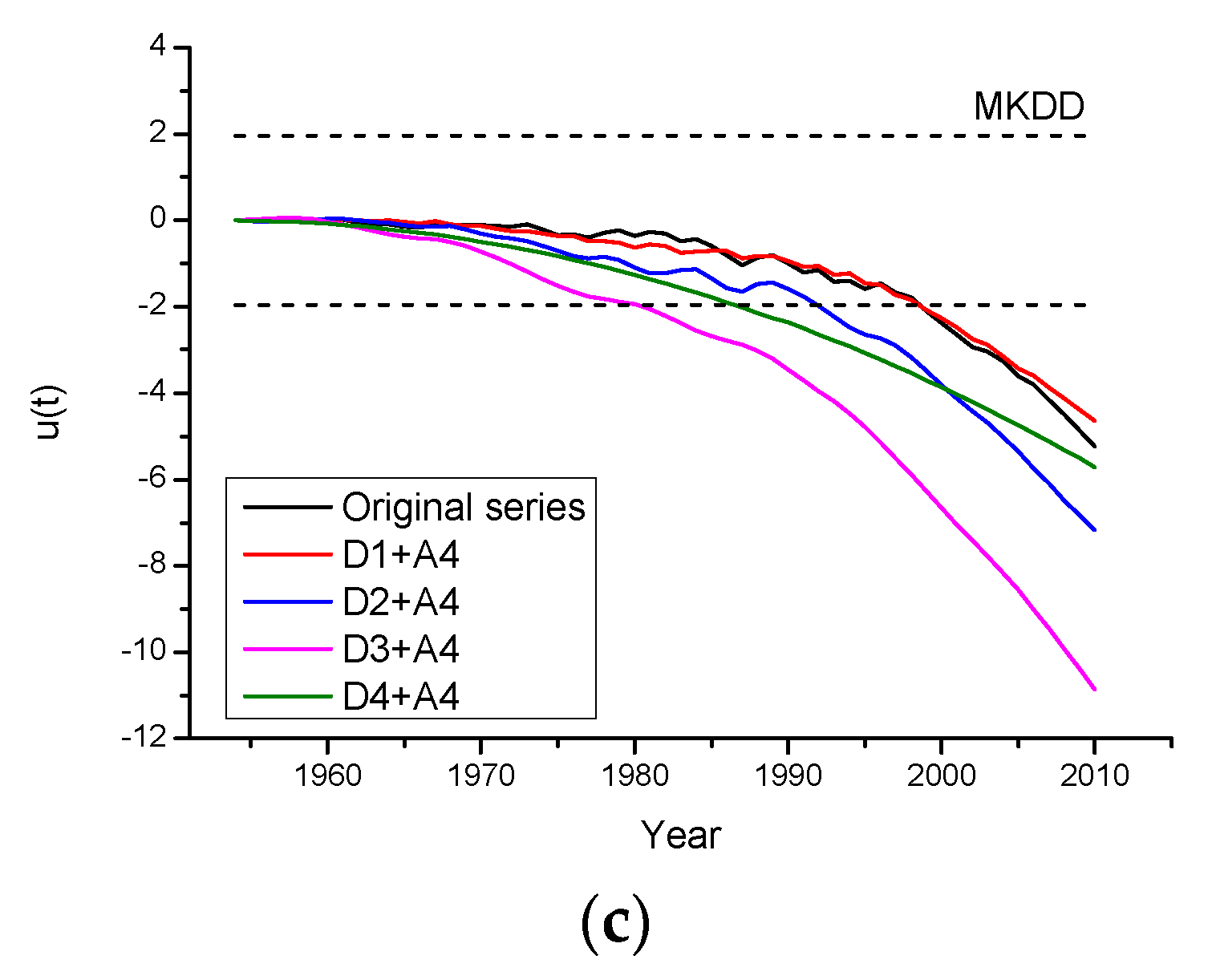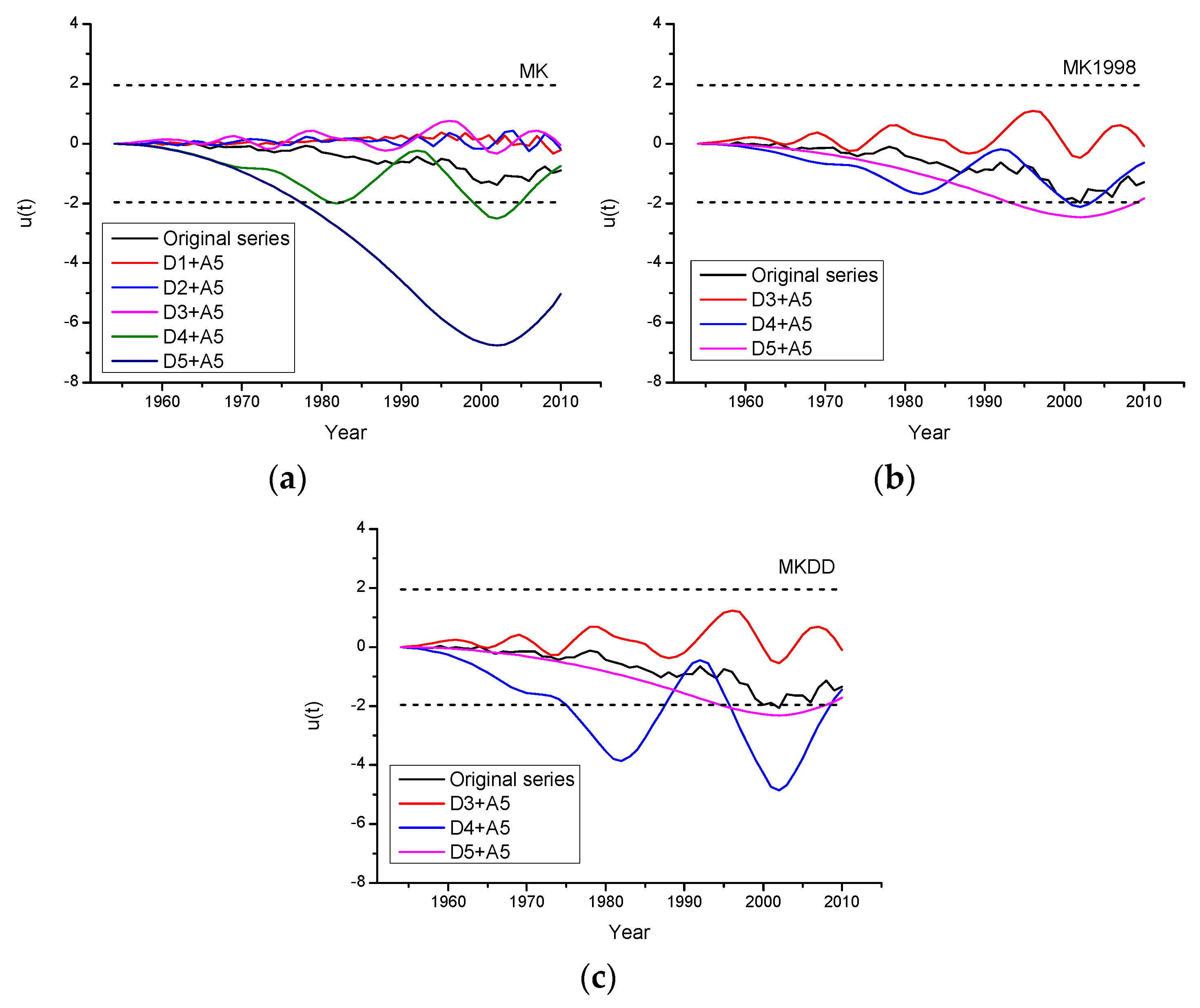1. Introduction
The processes that occur in the atmosphere and the earth’s surface, such as precipitation and streamflow, are mainly driven by the energy exchange between the sun, the earth and the atmosphere [
1]. The fifth IPCC assessment report [
2] indicated the mean annual global air temperature exhibited a significant upward trend during the period from the 1880–2012, and the greatest increase was noted from 1979 to 2012 with a 0.25–0.27 °C increment per decade [
3,
4]. One of the most obvious effects aroused by climate warming and change is to intensify the hydrological cycle [
5,
6]. Changes in hydrological cycle may in turn affect the availability and quality of water resources, and the sustainability of water management, particularly in dry regions [
7,
8,
9,
10].
The Yellow River is considered to be China’s mother river and the cradle of Chinese civilization, and it is a vital water source for hundreds of millions of people in the northern and north-western parts of China [
11]. The Yellow River is 5464 km long with a basin area of 0.8 million km
2, which is mainly comprised of arid and semi-arid environments [
12]. The Huangfuchuan basin, an important semiarid watershed in the middle reaches of the Yellow River, was selected as a meso-scale catchment representative of the semiarid climates that predominate across the Yellow River watershed, in order to detect the effects of climate variability and change. A better understanding of climate variability and change on both a basin and regional scale is obviously critical to water management and sustainable ecological conservation of arid and semiarid regions. Many studies which consider both climate variability and change have centered on the assessments in hydro-climate parameters such as temperature, precipitation and streamflow [
13,
14,
15,
16,
17,
18]. Hydrological variables have been considered as useful indicators of how the climate has changed and varied over time, therefore, it is needful to research trends associated with hydrological events [
19,
20].
The Mann-Kendall (MK) trend test has been widely used to trend detection in hydrology and climatology [
15], due to its rank-based procedure with resistance to the influence of extreme values that facilitate the skewness variables [
21,
22,
23]. But an obvious weakness of the MK test is that it is not accounting for the serial correlation which is very often seen in the hydro-climate data [
24,
25,
26]. Studies have demonstrated that the presence of positive autocorrelation overestimated the significance of (both positive and negative) trends, while negative autocorrelation underestimated the significance of (both positive and negative) trends, if the autocorrelation is not considered [
24,
25]. In an effort to remove the influence of serial correlation on the MK test, the modified MK test with lag one and trend-free pre-whitening [
25] and the modified MK test with variance correction were proposed and applied [
24,
26,
27]. Gautam and Acharya (2012) [
28] used trend-free pre-whitening to deal with serial and cross-correlation in detecting trends of streamflow in Nepal. However, Kumar
et al. (2009) [
29] found that consideration of only lag-1 autocorrelation is not sufficient to remove all significant serial correlation in the hydrological time series. Khaliq
et al. (2009) [
30] recommended the variance correction approach, because not only lag-1 but also higher lags are considered for serial correlation. However, Yue and Wang (2004) pointed out that the modified MK test with full autocorrelation structure is not powerful in the case that trend cannot be approximated by a linear trend [
26].
Wavelet analysis is another effective way to analyze the time series owing to its capability of illustrating the localized characteristics of a series both in temporal and frequency domains [
31,
32,
33]. Wavelet analysis has been extensively employed to determine the non-stationary trends and periodicities in the analysis of various hydrological and meteorological variables [
34,
35,
36,
37]. In order to better analyze the trends and the fluctuating patterns of the hydrological variables, the wavelet transform has been recently used in conjunction with the MK test [
20,
38,
39,
40]. Partal and Küçük (2006) [
22] firstly co-utilized the wavelet transform and the original MK test to find which periodicities are mainly responsible for the trends of the annual total precipitation series and found that the trend analysis on detailed components of the precipitation time series resulting from the discrete wavelet transform (DWT) can clearly explain the trend structure of data. Nalley
et al. (2012) [
20] used DWT to analyze trends in streamflow and precipitation in Quebec and Ontario with the modified MK test proposed by Hirsch and Slack (1984), which accounts for seasonality and serial dependence. However, this modified MK test is not powerful when there is long-term persistence (with autoregressive parameter >0.6) or when there are less than 5 years’ worth of monthly data [
41].
When applying DWT to the decomposition of hydrologic time series, two critical issues, wavelet choice and decomposition level, should be confirmed firstly. When choosing wavelet, both the wavelet’s properties and the hydrologic series’ composition should be considered [
42]. It is suggested that two conditions be followed, one is that the chosen wavelet must meet the regularity condition which is required for DWT [
43]; another is that the appropriate wavelet should satisfy the need of accurately separating deterministic series from original series [
42]. The Daubechies (db) wavelets not only meet these two conditions, but also are commonly used in hydro-meteorological wavelet-based studies [
44,
45,
46]. The number of decomposition levels needs to be confirmed in order to avoid unnecessary levels of data decomposition. This number is affected by the number of data points and the mother wavelet used. The highest decomposition level should be in agreement with the data point where the last subsampling becomes smaller than the filter length [
45]. The reason is that for signals with a finite length, convolution processes cannot perform at both ends of the signal since there is no information available outside these boundaries [
47]. As a consequence, we need to make an extension at both edges. Border extensions that are frequently used are symmetrization, periodic extension and zero-padding—each of them has its defect, because of the discontinuities introduced at both ends of the signals [
45,
47]. In order to determine the appropriate mother wavelet, the decomposition levels and extension mode, two criteria have been proposed by de Artigas
et al. (2006) and Nalley
et al. (2012) [
20,
45], and which will be discussed in detail in
Section 3.1.4.
The main purpose of this study is to investigate the possible trends and the basic structure of the trends in the mean streamflow and the total precipitation in Huangfuchuan watershed by analyzing its monthly, seasonal and annual time series through the wavelet transform and different MK tests. The trend analysis through different MK tests was examined at first for the selection of appropriate trend tests. Then the powerful trend tests were applied to determine the trends in the original data and the ones resulting from DWT. In the process of applying DWT, three criteria were used to determine the smooth mother wavelet, the decomposition levels, and the extension mode. In addition, a new criterion based on the relative error of energy between the original data and the approximation component decomposed from DWT was proposed and successfully employed in this study, and the usage of it was discussed in detail in
Section 3.1.4. Finally, the trend structure in precipitation and streamflow in Huangfuchuan watershed was identified by the wavelet transform and powerful MK tests. Additionally, a new powerful index, the energy of the hydrological time series, was proposed in this study and used to confirm the dominant periodic components for the observed trends, and is discussed in detail in
Section 4.3,
Section 4.4 and
Section 4.5.
2. Study Area and Data
The Yellow River consists of three major reaches, the upper, the middle and the lower reaches [
48], and the middle reach of the Yellow River watershed contributes significantly to the total streamflow and sediment discharge of the Yellow River [
49] The Huangfuchuan is a primary tributary of the right middle reach of the Yellow River with the length of the main channel 137 km and an average channel slope of 2.7% [
50]. The Huangfuchuan watershed (as shown in
Figure 1) is located at 110.3°~111.2°E and 39.2°~39.9°N, with a catchment area of 3246 km
2 that is characterized by a semi-arid continental climate. The basin’s average precipitation and mean temperature from 1961 to 2000 were 388 mm and 7.5 °C, respectively [
12]. The Huangfu gauging station started in 1954 with 3175 km
2 of control area, which accounts for 98% of the area of the whole watershed. This area has complex geomorphological types including a feldspathic sandstone hilly-gully region, the loess hilly-gully region and the sanded loess hilly-gully region [
51]. The Huangfuchuan basin is considered to be fairly vulnerable to climate change due to vegetation deterioration, soil erosion and land desertification [
12,
52].
Daily streamflow and precipitation observations from 1954 to 2010 for the Huangfu gauging station of the Huangfuchuan basin were provided by the Yellow River Conservancy Commission (YRCC). A large amount of work has been conducted by the YRCC to make sure of the quality of the data before they were released [
49,
53]. Stations with missing data of less than 3% can be considered as acceptable for hydrological research [
8]. However, the Huangfu gauging station has fully complete observations over the chosen period. Therefore, the data used in this study is considered to be good quality. Monthly, seasonal and annual mean streamflow and total precipitation data (see
Figure 2) were then collected and investigated in order to research short-term monthly variations (e.g., intra-annual and inter-annual cycles), seasonal cycles and long-term fluctuations such as multi-year, decadal and multi-decadal events [
20].
Burn and Elnur (2002) [
19] considered that the length of the time series of at least 25 years was required in order to obtain an average statistic in assessing the trends of the streamflow. In addition, Partal (2010) [
39] thought the length of the time series of 40 years was adequate for trend analysis studies. Kumar
et al. (2009) [
29] suggested that the same length of records should be used when analyzing trends of different variables to avoid misleading conclusions. Therefore, both the streamflow and precipitation of the same record length of 57 years for the period 1954–2010 would be adequate for the trend analysis in this study.
5. Conclusions and Recommendations
The wavelet transform and different MK tests were employed to investigate the possible trends and the basic structure of the trends in the mean streamflow and total precipitation in Huangfuchuan watershed. A comparative analysis of five different MK methods, including the original MK test and the modified MK tests with lag-one and full serial correlation, showed that consideration of only lag-1 autocorrelation (for TFPW and MKDD1) is not sufficient to remove all significant serial correlation in the data series. The results of the trend analysis also indicated the significant downward trends in all monthly, seasonal and annual mean streamflow series, but weak upward trends in monthly and seasonal total precipitation series and poor negative trends in the annual total precipitation series. Precipitation variation in Huangfuchuan basin has been closely linked to ENSO events [
48]. The combined effects of human activities and climate change account for the significant decreasing streamflow, however, intensive anthropogenic activities are the major factors [
7,
27,
49,
53,
68].
The modified MK tests (MK1998 and MKDD) that consider full serial correlation structure performed better than the original MK and the modified test for lag-1 autocorrelation (TFPW and MKDD1), because significant autocorrelations exhibit for more than just one lag in most of the wavelet decomposition components as well as for different combinations. But in the case that the slope β of the trend approaches zero, the two modified MK tests are not robust even though the existing trend can be approximated by linear trend. The original MK test performs worse when the ACF is high, as expected. However, the original MK test is still powerful in the case that the slope β of the trend approaches zero even though the ACFs of the series are extremely high (r > 0.9). Additionally, MK1998 and MKDD tests are not applicable to the analysis of monthly and annual total precipitation series, and this can be attributed to negative values of the correction factor cf. Further discussion is not explored here, since it had little influence on this study. But future studies are needed to improve the modified MK, with complete autocorrelation structure on this issue. In summary, this study suggests that the original MK test and the modified MK test for full serial correlation structure should be applied together to better analyze the trend in the hydrological time series and the wavelet decomposition components obtained from DWT.
Three criteria were explored to determine the most appropriate smooth mother wavelet, the decomposition levels and the extension mode in the DWT procedure. The result revealed that the criterion Er based on the relative error of energy that is proposed in this study performed better in comparison to the other two criteria, MAE and er. Additionally, the usage of Er is very convenient and is not influenced by the method itself compared to er (the effect of er is influenced by the MK test).
In addition to the MK Z values and the sequential MK graphs, a new and powerful index, the energy of the hydrological time series, was proposed and successfully utilized in this study to confirm the dominant periodic components for the trends. Furthermore, this index is easy to apply and has few limits. However, it is important to note that if there is no significant energy difference among different detail components with respective approximation, energy is no longer the key index to indicate which detail components are the most effective periodic component for the observed trend. Overall, from the energy of the hydrological time series point of view, this not only provides a robust index to determine which periodic component is the dominant periodic component for the trend, but also explores a new way of analyzing the hydrologic time series.
Intra-annual periodicities (6–12 months) were found to be the most influential components in producing the trends in monthly and seasonal series, which may be related to strong seasonal and annual cycles in monthly and seasonal data and human activities [
49,
64]. In the CWT and GWS of the annual series, the periodicities located between 2- and 4-year scales are seen, but the major periodicities are decadal events. Inter-annual (2, 4 and 8 years) and decadal (16 and 32 years) periodicities found in annual series are likely associated with 2–7-year ENSO cycles and the combination effects of 11-year solar activities and 2–7-year ENSO events, respectively [
48,
49,
67]. Additionally, although streamflow in the Huangfuchuan basin has been greatly influenced by human activities, the long-term fluctuations (decadal events) exhibited in annual streamflow are still evident. This indicates that the long-term fluctuations in streamflow are more influenced by climate variabilities (e.g., ENSO cycles, solar activities). However, the combined effects of ENSO events and solar activities in streamflow have not been extensively explored to date, especially in the yellow River basin. Thus, further studies could incorporate some linkages between the streamflow and combined climatic variabilities. The above findings will contribute to not only analyzing the trends in the hydrological time series, but also water resource planning and management in the semi-arid or arid river watersheds of China.
